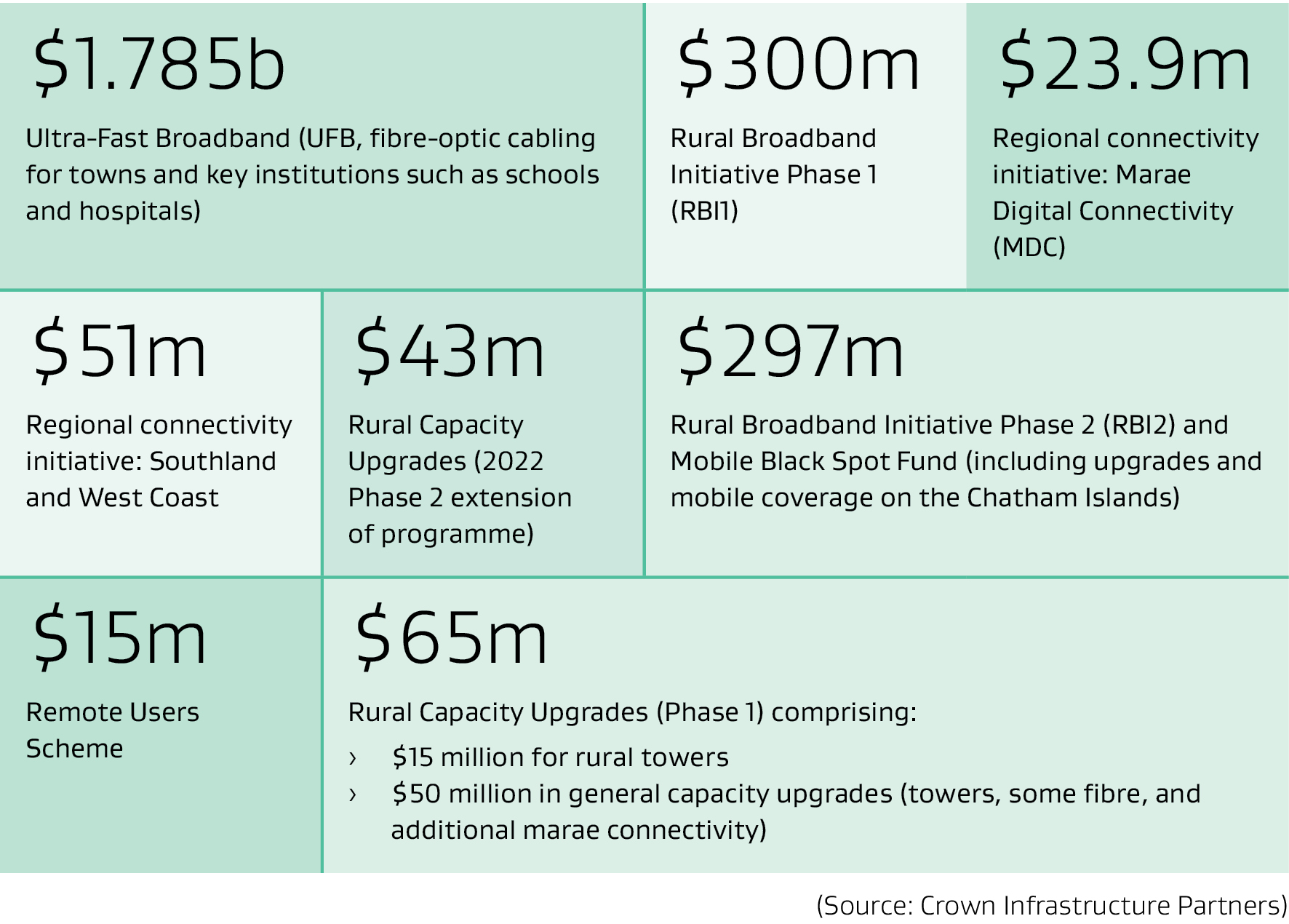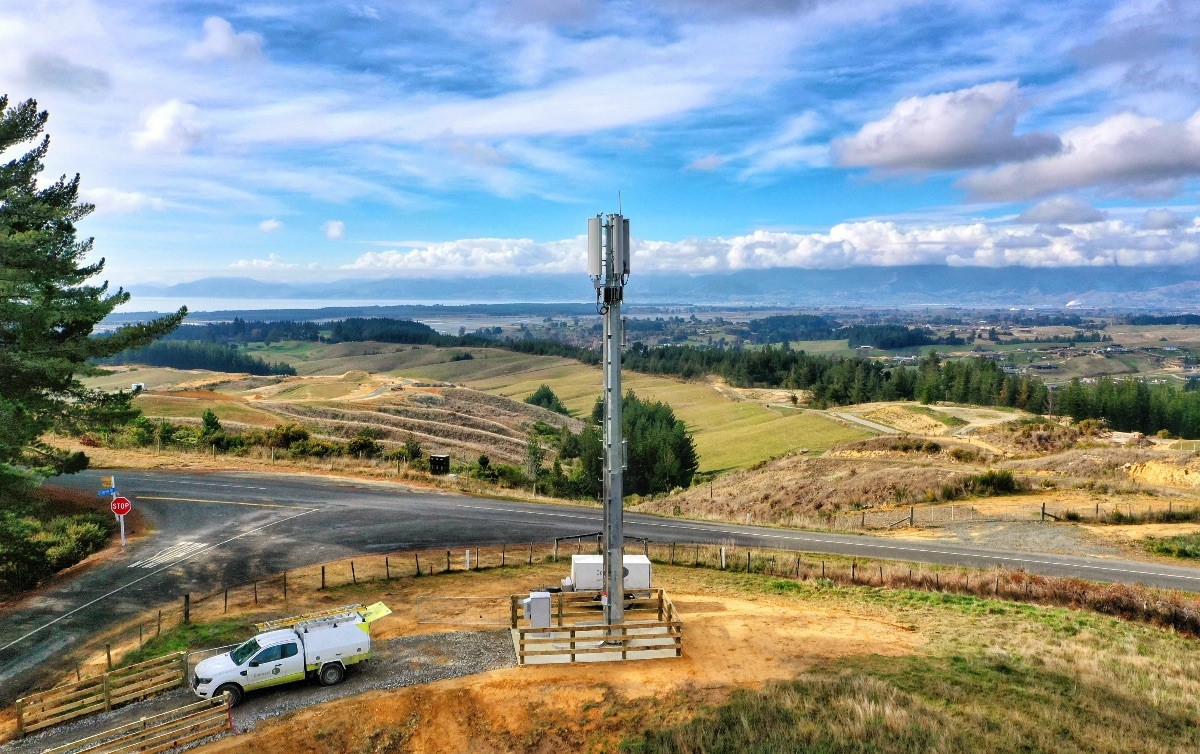Building on successful foundations
Digital connectivity progress we have made as a nation since the launch of the Ultra-Fast Broadband (UFB) programme in 2010.
On this page
Aotearoa New Zealand’s access to the digital world is enabled by a strong foundation, due to bold investment and a commitment from successive New Zealand governments to ongoing connectivity improvements. Since the launch of the UFB programme, major upgrades of New Zealand’s telecommunications infrastructure have been made, in partnership with private network operators, to lift the standard of New Zealand’s connectivity infrastructure and availability across both urban and rural areas.
Government investment (as allocated to programmes)

Text description
The digital connectivity progress we have made as a nation
2010
 Launch of UFB
Launch of UFB
Target set for 75% population with access to fibre, and all schools and hospitals with download speeds of 100 Mbps+
 Launch of RBI1
Launch of RBI1
Targets were to get 80% of rural households to speeds greater than 5Mbps, and others to speeds of greater than 1 Mbps
2015
 UFB
UFB
UFB builds complete for schools, public hospitals, most private health facilities and most businesses
2016
 Conclusion of RBI1
Conclusion of RBI1
Over 293,000 rural households and businesses able to access broadband.
355 cell towers upgraded, 154 new towers are live, 39 hospitals and health centres, 1,034 schools with fibre, 49 remote schools with improved connectivity, and extension of fibre by over 3,300km
![]() Launch of RBI2 and MBSF
Launch of RBI2 and MBSF
Targets set for 64,000 households able to connect to improved broadband; and mobile coverage for around 1,000 kilometres of state highways, more than 100 tourism spots, and 20% additional geographic coverage
2017
 UFB extended
UFB extended
Targets increased to 87% of households and businesses and to 412 towns by the end of 2022
 UFB
UFB
Number of towns with fibre: 22
Availability: 1.2 million including households and businesses, Uptake: 35%
 RBI2
RBI2
Rural Connectivity Group appointed to build 500 cell towers under RBI2 +MBSF
RBI2 target increased to 70,000 End User Locations (EUL)
2018
 RBI2
RBI2
Covers 31,755 homes and businesses 43% of target.
 UFB
UFB
Number of towns with fibre: 50 Availability: 1.4 million including households and businesses Uptake: 44%
 MBSF
MBSF
2 towers in rural areas and blackspots (plus, 167 site acquisition underway) Target increased to about 1,400km state highways and 168 tourism spots
 RBI2
RBI2
Target increased to 84,000 rural households and businesses
2019
 Marae Digital Connectivity (MDC) Announced
Marae Digital Connectivity (MDC) Announced
Target to cover all eligible marae (around 877) that apply, to provide broadband connections for five years and associated hardware
 RBI2
RBI2
Improved services to 38,662 homes and businesses, 46% of target
 UFB
UFB
Number of towns: 110 Population coverage 78%
Availability 1.6 million households and businesses
 MBSF
MBSF
25 towers in rural areas and blackspots 238km of state highway covered
26 tourism spots covered
2020
Rural Capacity Upgrades and Marae Digital Connectivity extension (COVID Recovery Fund) to relieve congestion on rural networks and extend Marae Digital Connectivity
 Rural tower upgrades
Rural tower upgrades
Capacity upgrades to at least 70 rural mobile towers
 RBI2
RBI2
62% of target, Improved service to 51,904 rural homes and businesses
 UFB
UFB
Uptake 60%, Number of towns 194 Availability 1.68 million households and businesses
 MBSF
MBSF
126 towers in rural areas and blackspots 629km of state highway covered
50 tourism spots covered
 MDC
MDC
177 marae connected, 79 with hardware installed
Regional connectivity initiatives launched
Hāwea-Fox Glacier and Te Anau-Milford Sound fibre links, and extension of mobile and UFB coverage on West Coast
2021
 RBI2
RBI2
80% of target
Covers 67,606 homes and businesses
Chatham Islands: 5 new mobile towers and improved backhaul works completed
 UFB
UFB
Uptake 65%
Number of towns 309
Availability 1.76 million households and businesses
 MBSF
MBSF
268 towers in rural areas and blackspots
877km of state highway covered
70 tourism spots covered
 MDC
MDC
475 marae connected
445 with hardware installed
2022
 Commencement of Works for Rural Capacity Upgrades (RCU)
Commencement of Works for Rural Capacity Upgrades (RCU)
Rural Capacity Upgrades contracted for 43,000- 47,000 rural households and businesses
 Māori/Crown Memorandum of Understanding on Radio Spectrum signed
Māori/Crown Memorandum of Understanding on Radio Spectrum signed
Landmark agreement for 20% spectrum allocated to Māori Spectrum Entity to be established in legislation by end 2022
 Rural Tower Upgrades
Rural Tower Upgrades
Upgrades completed on 70 towers
 Regional Connectivity Initiatives
Regional Connectivity Initiatives
Completion of Fox-Hāwea fibre link
Budget 2022 Package
Further capacity upgrades to benefit 26,000 additional rural households and businesses, an extension to the MDC, and for a Remote Users Scheme
Telecommunications sector investing in the future of connectivity
In addition to government investment in connectivity, the telecommunications sector invests approximately $1.6 billion a year in infrastructure. In 2020 New Zealand had the fourth-highest level of telecommunications investment in the OECD, when measured as a percentage of Gross Domestic Product (GDP).
Mobile network operators have provided 2G/3G/4G based services and now 5G to around 98% of New Zealand’s population with Wireless Internet Service Providers (WISPs) providing wireless internet coverage to over 70,000 additional New Zealanders in rural areas.
New Zealand has five international submarine cables that connect us to the rest of the world. Upon the completion of the fifth, New Zealand’s international fibre optic cable will have a total capacity of 72 Terabits of data per second (sufficient to screen more than 4.5 million Ultra high-definition 4K videos simultaneously).
Striving for world-class telecommunications infrastructure
Significant investment by the government and private sector over the last decade means we rank well amongst other countries for the standard of our connectivity infrastructure:
- New Zealand ranked 14th in the OECD for overall average fixed broadband speeds in 2021 (as sourced from Ookla data)
- New Zealand ranked in the top 8 OECD countries for the percentage of fibre connections of total fixed connections
- A recent report by the Commerce Commission comparing broadband services between Australia and New Zealand found that we had faster uploads and downloads in our fixed line and fibre plans, and fewer outages.
Our expectations of our connectivity networks are growing as New Zealanders increasingly engage with digital technology in more aspects of their daily lives. Twenty years ago, average download speeds experienced by users were around 250Kbps (sometimes much less in rural areas), a level of service that
today would not support many applications New Zealanders expect to access online. In 2022, 25-50 Mbps is considered a reasonable level of service to support High Definition (HD) video streaming, advances in technology mean that satellite services are able to deliver 100Mbps in remote locations, and fibre plans are available for Gigabit speeds.
With much of the backbone of our connectivity infrastructure in good shape, New Zealand is now in a position to focus on connecting the hardest to reach areas, and to maintain and build on the high standard of connectivity already in place.
Remote and rural New Zealanders are still not always able to access the connectivity they need. That is why we are investing in the next chapter of rural connectivity, to connect the hardest to reach areas. We are creating a $15 million Remote Users Scheme, to extend coverage and support use of innovative connectivity options for New Zealanders in remote and hard to reach areas. This will mean more New Zealanders have access to broadband and voice connectivity that meets their life, work and study needs.
The Government is continuing to work to understand the coverage, capacity and resilience needs of New Zealand’s telecommunications network.
Around $90 million from the COVID Recovery Fund and Budget 2022 has been invested in the Rural Capacity Upgrade programme. This investment is expected to provide better connectivity to approximately 70,000 rural homes and businesses.
Long-term rights to the 3.5 GHz spectrum are also being allocated to support roll-out of 5G wireless technology in New Zealand.
By the numbers - Government connectivity programmes over the last 5 years, as at March 2022
(Source: Crown Infrastructure Partners)
 Ultra-Fast Fibre
Ultra-Fast Fibre
774,500 households and businesses have taken up fibre connections in the last 5 years
1.8 million+ homes and businesses will be able to access fibre by the end of the UFB programme – 87% of New Zealand’s population
 Marae connected to broadband
Marae connected to broadband
563 connected
550 with hardware installed
 Rural Broadband 2 Initiative
Rural Broadband 2 Initiative
72,674 Rural homes and businesses able to access improved broadband
 Mobile Black Spot Fund
Mobile Black Spot Fund
984 km of state highways with new mobile coverage
86 Tourist locations with new mobile coverage
 Rural Capacity Upgrades
Rural Capacity Upgrades
332 new mobile towers built in rural areas
2,253 rural households and businesses with improved capacity broadband

Case studies
In this section
Case study: Ultra-Fast Broadband (UFB) Fibre expanding to small towns and urban fringe
The UFB public-private partnership model has been highly successful for supporting the delivery of fibre networks across Aotearoa New Zealand.
Case study: Targeted solutions in the isolated reaches of ranges
Isolated parts of the country present some of the greatest challenges to providing broadband and mobile coverage.
Case study: Improved connectivity on the Chatham Islands
In December 2021, mobile and broadband services were switched on for the 663 residents of Rēkohu / Wharekauri / Chatham Islands, around 800km from mainland Aotearoa New Zealand.
Case study: Improved connectivity to the West Coast and Southland
In March 2022 the first of 2 regional fibre links in the West Coast and Southland regions was completed.
Case study: Marae Digital Connectivity
In partnership with Crown Infrastructure Partners, Te Puni Kōkiri and Kānoa, the Marae Digital Connectivity Programme is making significant progress to enable marae to receive grant-funded broadband connections and associated hardware.

